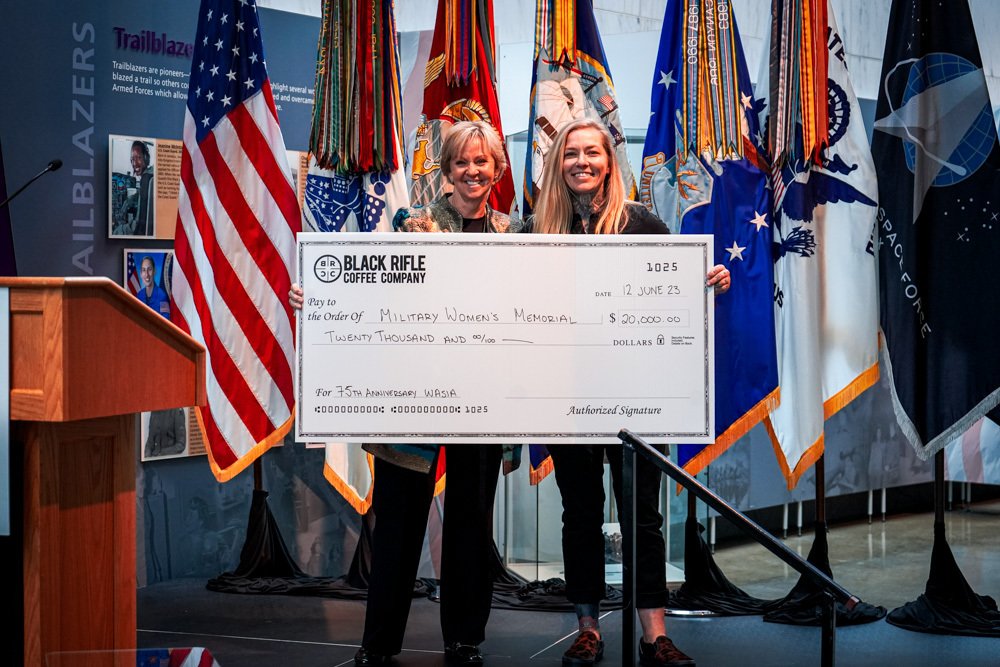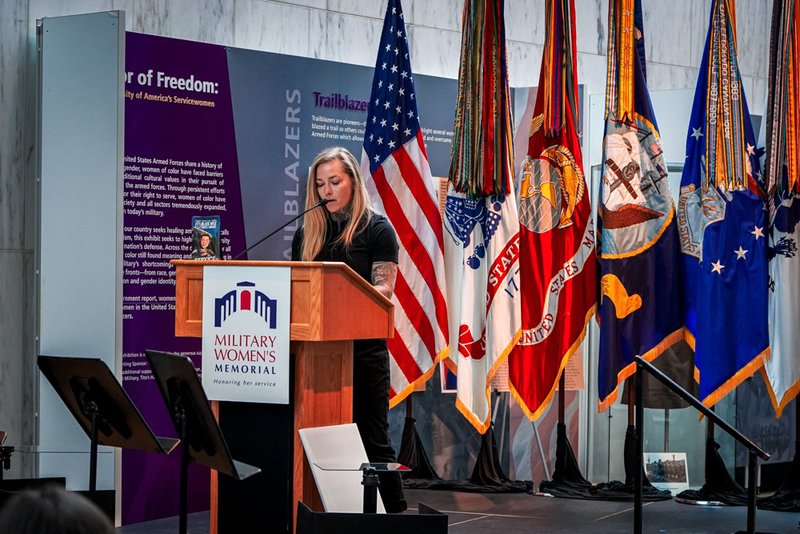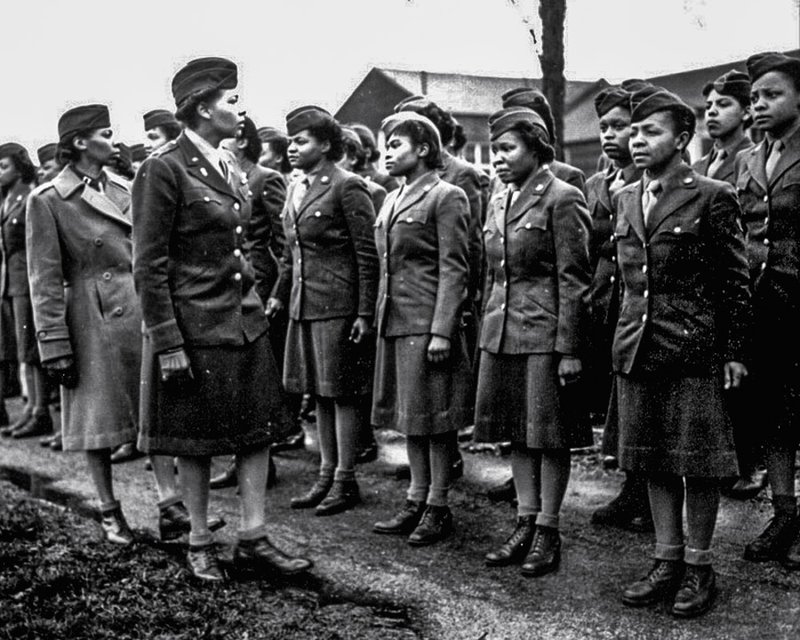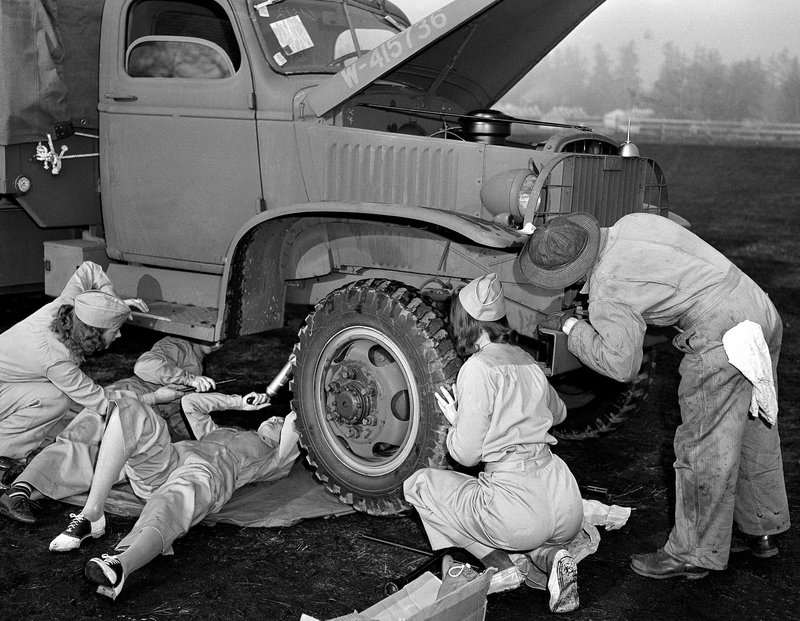BRCC Donates $20K in Honor of the Women's Armed Services Integration Act

Phyllis Wilson, left, accepts the check symbolizing the $20,000 donation from Black Rifle Coffee Company with Jenna Bakken on Monday, June 12, 2023, during the Military Women's Memorial's Women Veterans Recognition Day in Washington, DC. Photo by Lauren Warner/Coffee or Die.
It’s been 75 years since the passing of the Women’s Armed Services Integration Act, but let’s face it, women were finding ways to serve in the armed forces long before then.
In fact, it took Congress two years of legislative debate to pass the act that leadership within the military had been requesting for years.
You might think you know the history of women in the armed forces, but it’s not as simple as an act getting passed. There is generally more resistance to change during peacetime, but traditions break down during war — which is how women assumed more influential roles in the military.

Jenna Bakken, who works in media production for Black Rifle Coffee Company, speaks during the Military Women's Memorial's Women Veterans Recognition Day on June 12, 2023, in Washington, DC. Photo by Lauren Warner/Coffee or Die.
In honor of the 75th anniversary of the Women’s Service Integration Act, Black Rifle Coffee Company’s Jenna Bakken helped create a coffee bag honoring the women who paved the way for women serving today.
On Monday, June 12, BRCC attended the Military Women’s Memorial’s Women Veterans Recognition Day in Washington, DC, and presented the foundation with a $20,000 donation. The Military Women’s Memorial is the only historical repository documenting the service of women in the military and is responsible for educating the public through exhibits and programming, which the donation will support.
“We’ve never had a women-centric bag, and we’re a veteran coffee company, so what better way to bring this in than highlighting the [Service Integration] Act?” Bakken said to Coffee or Die prior to the event. “It’s important to recognize that women weren’t always allowed to serve and, as a female veteran myself, I think this is a great opportunity to bring attention to the history behind women serving in the military.”
A Brief History of Women in Service

Maj. Charity E. Adams and Capt. Abbie N. Campbell inspect the first contingent of African American members of the Women’s Army Corps assigned to overseas service. Photo courtesy of National Archives.
Traditional military roles for women used to mean being a nurse, seamstress, or cook in a military camp, but that didn’t work for everyone. Imagine being offered the option to prepare food for a bunch of grimy guys or delve deep into the world of espionage — many women dating back to the 1700s wanted the latter. From serving on the front lines to spying and earning a pension for their courageous actions, women have been integral to the US military since its inception.
Stories like those of Deborah Sampson, who served in the Continental Army during the Revolutionary War, and Sarah Edmonds, who went from a field nurse to a Union spy during the Civil War, are more common than expected. Thanks to less rigorous physical exams than what a recruit experiences today at Military Entrance Processing Station, or MEPS, forged paperwork and basic disguises worked well enough to fool recruiters and troops, allowing women to fight alongside their male counterparts. Since women were forbidden from legitimately enlisting, there is no official estimate of the number of women who served in the earlier wars of the United States.
Service Roast: Check out BRCC's latest coffee honoring the Women's Armed Service Integration Act

WACs at Bolling Field use a theodolite to obtain data on upper airflow of a balloon. Photo courtesy of US Air Force Historical Support Division.
The response to women in service was split. For every warm reception a woman received after returning from battle, there was a Capt. Benedict J. Semmes. Semmes served with the Confederate Army and held the opinion that women who wanted to serve were perhaps quite literally insane.
When Semmes reflected on the capture of Dr. Mary Edwards Walker — the first female US Army surgeon in the Civil War— he stated, “[We] were all amused and disgusted … at the sight of a thing that nothing but the debased and depraved Yankee nation could produce. She was dressed in the full uniform of a Federal Surgeon … not good-looking, and of course, had tongue enough for a regiment of men … she would be more at home in a ‘lunatic asylum.’”

Some 1,000 members of the Women’s Ambulance and Defense Corps of America staged extensive mimic maneuvers at Santa Catalina Island, in a demonstration of technique and training acquired since their organization was formed. One of 27 units disembarking after arrival at Avalon, California, July 28, 1941, by steamer. The corps is composed of women volunteers who devote two nights each week to military drills and schooling. AP photo by Ed Widdis.
Women’s units, when they did exist, only existed in wartime. For example, when World War I ended, the roughly 34,000 women serving were demobilized save for a small number of Army and Navy nurses. It’s the same story after nearly every war; as soon as “normal life” resumes, so do the old rules. World War II was the beginning of the first big change in women’s service when it quickly became apparent that female participation was necessary to win the war.
Starting in December 1941, 350,000 women — with no need for disguises or forged papers — served in their own newly formed branches of service. However, even with the creation of the Women’s Army Auxiliary Corps (WAC), Women Airforce Service Pilots (WASP), Women Accepted for Volunteer Military Services (WAVES), and United States Coast Guard Women’s Reserve (SPARS), nearly 70% of these jobs were still traditionally “female.”

WAC members work in the motor pool. Photo courtesy of Army Heritage Center Foundation.
From typists to clerks to mail sorters, the positions weren’t glamorous, but they were integral. Congress gave the WAC enlistees full Army status during World War II instead of being marked as volunteers on the force. The most dangerous jobs offered were those within the medical corps, the closest women could get to the front lines.
Who Passed the Women’s Armed Services Integration Act?
The leadership of the US Army requested that Congress find a way to keep the Women’s Army Corps active outside of wartime operations. Two years later, on June 12, 1948, the Women’s Armed Services Integration Act was signed into law, legally permitting women to serve in all four branches of the US military in a number of official capacities.

BRCC's Service Roast pays homage to women in service and the Women's Armed Services Integration Act. Photo by Black Rifle Coffee Company.
Related: Kati Garner: The First Female Navy Diver in US Military History
Although the act promised more opportunities for women, it also limited the number of women who could serve to 2% of the total number of enlistees per branch. The Women’s Armed Services Integration Act, coupled with President Harry Truman’s executive order to desegregate the military, also permitted African American women to serve. Annie E. Graham became the first Black woman to join the Marine Corps in 1949.
The State of Women’s Service Today
The story of women’s integration into the military is ongoing. Women weren’t allowed into service academies until the 1970s, they weren’t allowed to get pregnant and stay in the military until 1975, and they weren’t allowed to serve on Navy combat ships until the 1990s.

US Army Capt. Kristen Griest, left, Maj. Lisa Jaster, center, and First Lt. Shaye Haver, right, pose together after an Army Ranger School graduation ceremony, Friday, Oct. 16, 2015, in Fort Benning, Georgia. Jaster, who is the first Army Reserve female to graduate the Army's Ranger School, joins Griest and Haver as the third female soldier to complete the school. AP photo by Branden Camp
It wasn’t until 2013 that former Defense Secretary Leon Panetta and former Joint Chiefs Charman Gen. Martin Dempsey put the wheels in motion to “remove all unnecessary gender-based barriers to service” — meaning that women could serve in combat roles. In the last 10 years, more roles within the military have been opened to any and all qualified applicants, regardless of gender.
Since the integration act was signed, the military has undergone several significant changes and continues to be a leader on issues such as equal pay. Congress is even debating whether women should be required to sign up for the draft, just like men. From the first female Navy fighter pilot — retired Capt. Rosemary Mariner — to the first female Army Rangers — Capts. Kristen Griest and Shaye Haver — women are being offered more opportunities in the military and proving they are up to the challenge.
Read Next: West Point and Ranger School Graduate Lisa Jaster on Earning the Tab

Lauren Warner is the managing editor of the BRCC Blog. She's only slightly connected to the military community, growing up as an Army brat before serving in the Army herself as a public affairs specialist, then becoming an Army spouse and caregiver. With degrees in English, journalism, and a master's in marketing, to say that she enjoys reading and writing might be an understatement. She spends her free time drinking too much coffee and going on adventures with her husband and three dogs (yes, they're all rescues).
BRCC and Bad Moon Print Press team up for an exclusive, limited-edition T-shirt design!
BRCC partners with Team Room Design for an exclusive T-shirt release!
Thirty Seconds Out has partnered with BRCC for an exclusive shirt design invoking the God of Winter.
Lucas O'Hara of Grizzly Forge has teamed up with BRCC for a badass, exclusive Shirt Club T-shirt design featuring his most popular knife and tiomahawk.
Coffee or Die sits down with one of the graphic designers behind Black Rifle Coffee's signature look and vibe.
Biden will award the Medal of Honor to a Vietnam War Army helicopter pilot who risked his life to save a reconnaissance team from almost certain death.
Ever wonder how much Jack Mandaville would f*ck sh*t up if he went back in time? The American Revolution didn't even see him coming.
A nearly 200-year-old West Point time capsule that at first appeared to yield little more than dust contains hidden treasure, the US Military Academy said.












